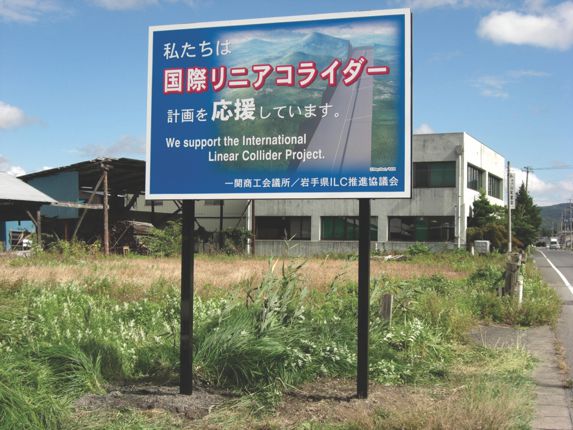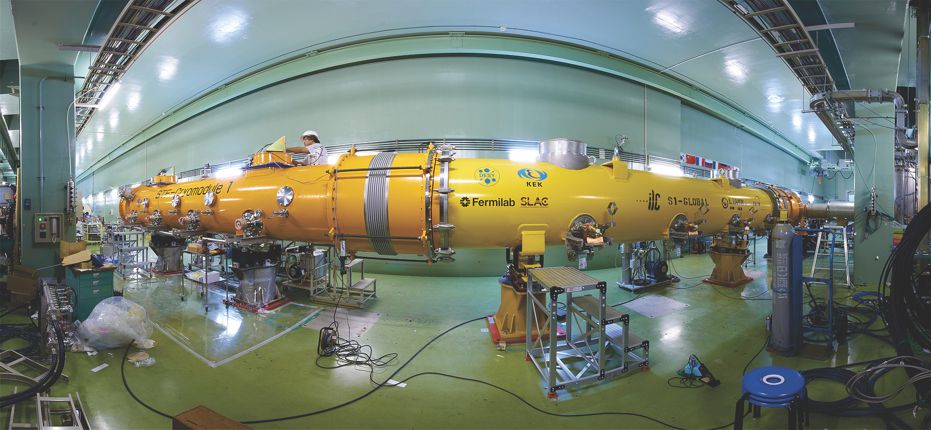Momentum grows to build International Linear Collider in Japan
DOI: 10.1063/PT.3.1910
Particle physicists the world over are eager to know more about the new boson, announced by CERN last summer to be “consistent with the Higgs” (see Physics Today, September 2012, page 12
The technical design for the next-generation accelerator was completed this past December and, says design team leader Barry Barish of Caltech, “I think it will happen in Japan in the next two or three years, or not at all.” At present, no other country or region is in a position to pony up billions of dollars to host the ILC. In Europe money for high-energy physics will be tied up in the Large Hadron Collider (LHC) for at least the next decade, and the US political situation makes it a nonstarter. China wants to participate but has made no move to host the ILC.
Japan, however, has itched for a global scientific facility since even before it lost its bid to host ITER, the fusion demonstration reactor under construction in France. And now the ILC is attracting backers in Japan’s public, industrial, and political spheres. It is seen as a way both to help internationalize the country and to maintain or retake a world-leading role in science. What’s more, Japan may be able to pay its share out of more than ¥25 trillion (about $270 billion) in government funds earmarked for restoring the country and rebuilding the economy after the 2011 Great East Japan Earthquake (see Physics Today, November 2011, page 20
“The number one question”
In Japan, the plan would be to build the ILC in phases, starting at 250 GeV, then extending to 500 GeV, and, depending on LHC results, potentially to 1 TeV. In colliding 125-GeV electrons with 125-GeV positrons, about 1% of ILC collisions are expected to produce the Higgs-like bosons. The new boson would be easier to find and the collisions easier to analyze with the ILC than with the messier proton–proton collisions at the LHC.
A 250-GeV ILC would allow scientists to figure out if the new boson really is the Higgs. “That’s a new kind of particle, and if it’s true, it needs to be demonstrated,” says Barish. By measuring the coupling between the new boson and other particles—photons, various quarks and leptons, and so on—the ILC would get at the question, “Is the Higgs the ultimate source of mass for everything?” says SLAC theorist Michael Peskin. “This is the number one question in particle physics in my mind.” If the couplings lie on a straight line proportional to mass, then the particle is the Higgs. If instead there are deviations, says Peskin, then “the pattern should give us hints as to how [the correct theory] differs from the standard model.” Upgraded to at least 350 GeV, the ILC could be used to study the top quark.
Important for high-energy physics, yes, but the ILC goals are pretty abstract for the general public. Yet the election platform of Japan’s Liberal Democratic Party mentions the ILC: “We will actively promote the critical fields of energy creation, energy conservation, energy storage, etc. as knowledge-concentrated national strategies—for example, our country should be able to play a leading role in creation of international centers for scientific innovations such as the ILC project, which is a grand project in the field of particle physics.” In 2006 some Diet members formed a group to support the ILC in Japan; that group has now grown to close to 100 members across all key political parties. Another thumbs up comes from the Japan Policy Council, an influential think tank that forms long-term strategies for the country.
Japan’s Advanced Accelerator Association for Promoting Science and Technology, whose members include nearly 100 companies, is actively campaigning for the ILC. “It would bring jobs,” says Masanori Matsuoka, manager of Mitsubishi Heavy Industries and secretary general of the AAA. “This project is very important to realize innovation in Japan.” The AAA estimates that construction alone would infuse the host region with up to $22 billion.
The project is even gaining support among Japan’s public, helped perhaps by two recent best-selling books—What Is the Universe Made Of? and Is There More Than One Universe?—by physicist Hitoshi Murayama, director of the Kavli Institute for the Physics and Mathematics of the Universe at the University of Tokyo and a professor at the University of California, Berkeley. Public support is key, says the University of Tokyo’s Sachio Komamiya, who chairs the international board that oversees development of a linear electron–positron collider. He hopes the public will see the ILC as a boon for the economy: “We need strong medicine to recover from the economic depression.”
Going granite
Two sites in Japan are being studied. In the north, in the area devastated by the 2011 earthquake, Iwate Prefecture included Kitakami for the ILC in its recovery proposal. The other possible site is in the south, in Kyushu—which is closer to Seoul, South Korea, than to Tokyo. In both places the idea would be to use the ILC as a centerpiece to “transform a regional city into a global city that attracts talent and investment from around the world,” according to the Japan Policy Council. The sites are about 100 kilometers and 20 kilometers from Tohoku and Kyushu Universities, respectively.
Both sites would involve drilling into geologically stable granite mountains. “The access is near horizontal, so you don’t drop things down vertically 100 meters like at the LHC,” says Barish. The biggest change to the design that putting the ILC in a tunnel introduces is in how the linac is powered. At 300–400 meters below the surface, the tunnel design puts the machine too far to power the machine remotely, so “instead of piping the RF down in clusters, you would distribute the RF along the whole linac.”
“Window of opportunity”
The ILC design team estimates it will cost $7 billion to $8 billion in 2012 dollars to build the collider. That does not include contingencies, inflation, country-specific costs, or laboratory manpower. Japanese high-energy physicists have hatched a scheme to jumpstart the project: Japan could foot up to 70% of the cost for the first, 250-GeV phase, but by the time the machine was extended to accelerate to 500 GeV, other countries would put in enough to bring Japan’s total share down to 50%. Of course, payment and contribution arrangements are subject to high-level international political negotiations. At a press conference in January, Japan’s minister of education, culture, sports, science, and technology stated that his country would start calling for negotiations with Europe and the US in the first half of this year.
Meanwhile, high-energy physicists in Europe and the US are in the process of setting research priorities and will make known their positions in the next few months. A draft European strategy from late January endorses an electron–positron collider as scientifically complementary to the LHC and welcomes an initiative by Japan to host such a machine; the draft will be considered this month by the CERN Council. The ILC is not the only potential LHC successor being discussed in the community—a circular Higgs factory, possibly using CERN’s LHC tunnel (originally built for the Large Electron–Positron Collider), has proponents. In the political dance inherent to a global project of the ILC’s scale, positive signals from partners would be needed before Japan would officially propose to host the ILC. Besides the US and Europe, the obvious likely partners are Canada, China, South Korea, India, and perhaps emerging countries in South America.
In the US, particle-physics efforts are now focused on neutrinos. With budgets tight, one question is whether the US could afford both to build up its own neutrino program and to make a hefty—probably around 10%—contribution to the ILC. That, of course, is a decision to be made at a policy level. But US high-energy physicists hope that national interest in fostering collaboration among the many expected ILC partners will compel the US government to find new pots of money for the project.
“We have a window of opportunity,” says Komamiya. “We had the earthquake, the Higgs, the technical design, and last October Japanese high-energy physicists issued a strong statement in favor of taking leadership of the ILC. If we wait too long, the enthusiasm will be lost.” If things go smoothly, Japan might make a proposal within a couple of years. Ideally, Komamiya says, “the ILC would start up [in the late 2020s] when the LHC is winding down.”

A roadside sign in Japan advertises support for the International Linear Collider.
ICHINOSEKI CITY


In a milestone for distributed production of the International Linear Collider, a prototype cryomodule assembled from components made by companies in Japan, the US, and Europe successfully passed compatibility tests. Such cryomodules, consisting of niobium cavities with superconducting cooling and insulating barriers, form the basic building blocks of the ILC.
KEK

More about the Authors
Toni Feder. tfeder@aip.org
